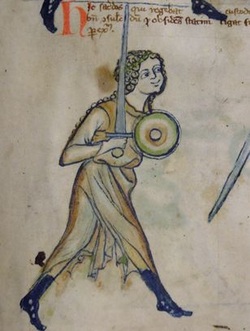
The article stated that when a knight died, his land passed to his wife or daughter. The woman was then responsible for the duties that went along with the land, including a certain number of days on campaign, if called up.
What the article didn't say was that usually the lady in question either hired knights to fulfill her obligation, or, even more regularly, married. Often, her liege lord would tell her who it was she would marry and she would have no say in the matter. (Birgitta finds herself in a similar situation in my medieval novel On Fledgling Wings.)
But there were women during the Middle Ages who were warriors. In "The Woman Warrior: Gender, Warfare, and Society in Medieval Europe," Women's Studies, 17, 1990, Megan McLaughlin says that women warriors were certainly more common" during the Middle Ages "than has usually been assumed,"
One example of a medieval woman warrior is Sichelgita of Salerno, a twelfth-century noblewoman who fought side by side with her husband, Robert of Hautevilleon.

Oronata Rodiana, an Italian woman who died in 1452, was an artist who fought off a young nobleman who attempted to rape her. She escaped to the mountains, where she joined a group of mercenary soldiers. She died defending her town, Castelliono, years later.

